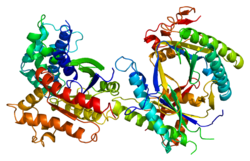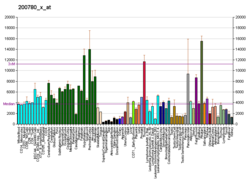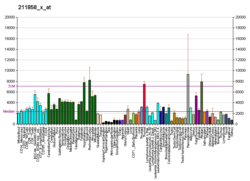The Gs alpha subunit (G
Function
editThe general function of Gs is to activate intracellular signaling pathways in response to activation of cell surface G protein-coupled receptors (GPCRs). GPCRs function as part of a three-component system of receptor-transducer-effector.[6][7] The transducer in this system is a heterotrimeric G protein, composed of three subunits: a G
Although each GTP-bound Gs
Receptors
editThe G protein-coupled receptors that couple to the Gs family proteins include:
- 5-HT4, 5-HT6 and 5-HT7 serotonergic receptors
- Adenosine receptor types A2a and A2b
- Adrenocorticotropic hormone receptor (a.k.a. MC2R)
- Arginine vasopressin receptor 2
β -adrenergic receptors typesβ 1,β 2 andβ 3- Calcitonin receptor
- Calcitonin gene-related peptide receptor
- Corticotropin-releasing hormone receptor
- Dopamine D1 and D5 receptors
- Follicle-stimulating hormone receptor
- Gastric inhibitory polypeptide receptor
- Glucagon receptor
- Growth-hormone-releasing hormone receptor
- Histamine H2 receptor
- Luteinizing hormone/choriogonadotropin receptor
- Melanocortin receptor: MC1R, MC2R (a.k.a. ACTH receptor), MC3R, MC4R, MC5R
- Olfactory receptors, through Golf in the olfactory neurons
- Parathyroid hormone receptors PTH1R and PTH2R
- Prostaglandin receptor types D2 and I2
- Secretin receptor
- Thyrotropin receptor
- Trace amine-associated receptor 1
- Vasopressin receptor 2
See also
editReferences
edit- ^ a b c GRCh38: Ensembl release 89: ENSG00000087460 – Ensembl, May 2017
- ^ a b c GRCm38: Ensembl release 89: ENSMUSG00000027523 – Ensembl, May 2017
- ^ "Human PubMed Reference:". National Center for Biotechnology Information, U.S. National Library of Medicine.
- ^ "Mouse PubMed Reference:". National Center for Biotechnology Information, U.S. National Library of Medicine.
- ^ Ellis C, Nature Reviews Drug Discovery GPCR Questionnaire Participants (July 2004). "The state of GPCR research in 2004". Nature Reviews. Drug Discovery. 3 (7): 575, 577–626. doi:10.1038/nrd1458. PMID 15272499. S2CID 33620092.
- ^ a b c d e Gilman AG (1987). "G proteins: transducers of receptor-generated signals". Annual Review of Biochemistry. 56: 615–649. doi:10.1146/annurev.bi.56.070187.003151. PMID 3113327. S2CID 33992382.
- ^ a b c d e Rodbell M (1995). "Nobel Lecture: Signal transduction: Evolution of an idea". Bioscience Reports. 15 (3): 117–133. doi:10.1007/bf01207453. PMC 1519115. PMID 7579038. S2CID 11025853.
- ^ Purves D, Augustine GJ, Fitzpatrick D, Hall WC, LaMantia AS, White LE, eds. (2007). Neuroscience (4th ed.). New York: W. H. Freeman. p. 155. ISBN 978-0-87893-697-7.
External links
edit- G(s)alpha at the U.S. National Library of Medicine Medical Subject Headings (MeSH)
- GNAS+protein,+human at the U.S. National Library of Medicine Medical Subject Headings (MeSH)
- Overview of all the structural information available in the PDB for UniProt: P63092 (Guanine nucleotide-binding protein G(s) subunit alpha isoforms short) at the PDBe-KB.







